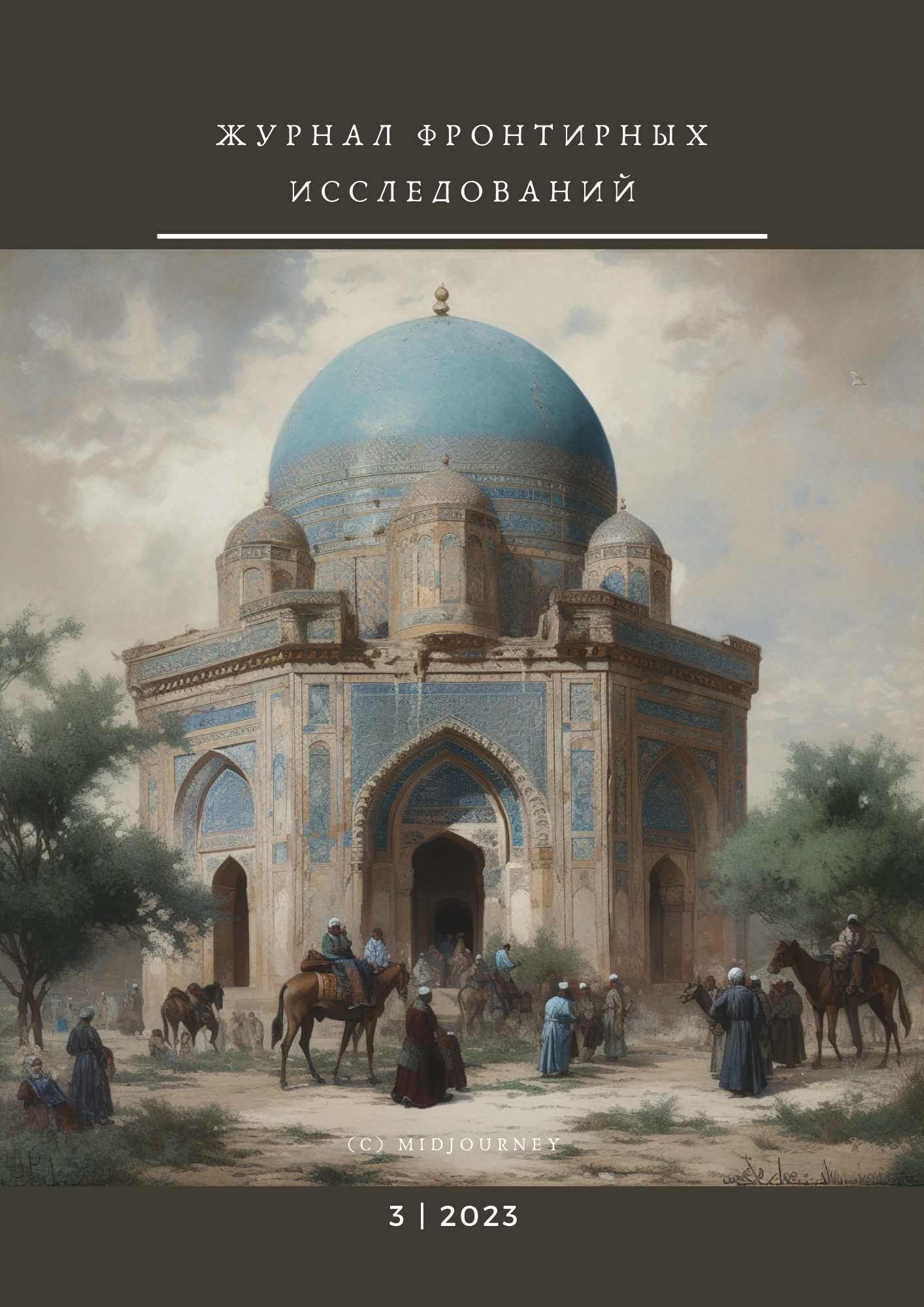Abstract
The study highlights the specifics of the professional activities of caravan masters from the khanates of Central Asia who controlled the movement of caravans in Russian-Asian trade in the first half of the 19th century. The article examines the social status of the caravan masters, defines their authority and main duties during the journey to trading locations, analyzes the features of interpersonal interaction between the leaders and other caravan members, and focuses on the moral and psychological qualities of the caravan leader.
From the moment the caravan set out on a long and dangerous journey through the steppe and desert areas, the caravan master, officially approved by the government of a Central Asian khanate, gained full control over the process of movement. Taking full responsibility for the life and health of the caravan personnel, as well as the safety of the goods, the leader chose the optimal route, determined the locations for stops, controlled the duration of rest, and monitored provisions consumption.
The study demonstrates that the official duties of the caravan leader in the unique logistical setting of a merchant caravan were accompanied by various tasks, the effective solution of which depended on the leader’s business mentality and special skills. The archival materials used in this work are being introduced into scientific circulation for the first time.
References
Abzalov, L. F., Gatin, M. S., Mustakimov, I. A., & Pochekaev, R. Yu. (2022). New historical insights on protection of the trade routes in Genghisids states, 13th to 14th century. Proceedings in Archaeology and History of Ancient and Medieval Black Sea Region, 14, 297–313. https://doi.org/10.53737/2713-2021.2022.89.86.014 (In Russian).
Burlutskaya, E. V., & Abdrakhmanov, K. A. (2020). The Daily Business Activities of Orenburg Merchants Trading with Asia in the 19th Century. RUDN Journal of Russian History, 19(3), 544–562. https://doi.org/10.22363/2312-8674-2020-19-3-544-562 (In Russian).
Dal', V. I. (2001). Bikey i Maulyana. In Orenburgskiy kray v khudozhestvennykh proizvedeniyakh pisatelya (pp. 213‒289). Orenburgskoe knizhnoe izdatel'stvo. (In Russian).
Erofeeva, I. V. (1997). Kazakhskie khany i khanskie dinastii v XVIII ‒ seredine XIX vv. In Kul'tura i istoriya Tsentral'noy Azii i Kazakhstana: problemy i perspektivy issledovaniya. Materialy k Letnemu Universitetu po istorii i kul'ture Tsentral'noy Azii i Kazakhstana. Almaty, 4‒23 avgusta 1997 g., 46–144.
Germanov, V. A., & Kruchenitskiy, G. M. (2014). Karavan: Vostochnyy fenomen logistiki. Ru Science, 1(1), 40–50. (In Russian).
Gizatullin, R. N. (2010). “Mnogie bukhartsy priezzhayut syuda pozhit' na raspashku...” (sredneaziatskaya diaspora v dorevolyutsionnom Troitske). Gorokhovskie chteniya. Materialy pervoy regional'noy muzeynoy konferentsii, 170–174. (In Russian).
Levshin, A. I. (1996). Opisanie kirgiz-kazach'ikh, ili kirgiz-kaysatskikh, ord i stepey. Sanat. (In Russian).
Lysenko, Yu. A. (2018). Slave Trade and Slavery in the Central Asian Outskirts of the Russian Empire (XVIII–XIX centuries). Bylye Gody, 47(1), 172−182. https://doi.org/10.13187/bg.2018.1.172 (In Russian).
Madzhlisov, A. (1967). Agrarnye otnosheniya v Vostochnoy Bukhare v XIX ‒ nachale KhKh veka. Irfon. (In Russian).
Mikhaleva, G. A. (1962). K voprosu o diplomaticheskikh snosheniyakh mezhdu Rossiey i Bukharoy cherez Orenburg v kontse XVIII– nachale XIX veka. Obshchestvennye nauki v Uzbekistane, 7, 55−59. (In Russian).
Mikhaylov, M. (1866). Orenburgskie pis'ma dlya zhelayushchikh oznakomit'sya s Orenburgom, Orskom, Troitskom, Fortom Aleksandrovskim i dorogoyu cherez Kirgizskuyu step' do Forta № 1. Tipografiya N. Tiblena i kom. (In Russian).
Minsky, M. Yu. (2009). Microhistorical Method and Macrohistorical Conclusion. Moscow University Bulletin. Series 7. Philosophy, 3, 67–77. (In Russian).
Nebol'sin, P. I. (1855). Ocherki torgovli Rossii so Sredney Aziey. Zapiski Imperatorskogo russkogo geograficheskogo obshchestva, Kn. X. Tipografiya Imperatorskoy Akademii nauk. (In Russian).
Rozhkova, M. K. (1963). Ekonomicheskie svyazi Rossii so Sredney Aziey: 40‒60-e gg. XIX v. Akademiya nauk SSSR. (In Russian).
Sapunov, D. A. (2004). Sud'boyu svyazannyy s Vostokom: I. V. Vitkevich i russkaya razvedka v Sredney Azii. Bulletin of Chelyabinsk State University, 1, 114–120. (In Russian).
State Archive of Astrakhan Region (SAAR). (1835-1837). F. 2. In. 1. C. 185. (In Russian).
United State Archive of the Orenburg Region (USAOR). (1806). F. 6. In. 10. C. 276. (In Russian).
United State Archive of the Orenburg Region (USAOR). (1818-1820). F. 6. In. 10. C. 1644. (In Russian).
United State Archive of the Orenburg Region (USAOR). (1834-1835). F. 6. In. 10. C. 4150. (In Russian).
Uralov, N. (1897). Na verblyudakh: Vospominaniya iz zhizni v Sredney Azii. Tipografiya P. P. Soykina. (In Russian).
Vamberi, A. (1863). Puteshestvie po Sredney Azii: Opisanie poezdki iz Tegerana chrez Turkmenskuyu step' po vostochnomu beregu Kaspiyskogo morya v Khivu, Bukharu i Samarkand, sovershennoy v 1863 godu Arminiem Vamberi, chlenom Vengerskoy akademii. Tipografiya Yu. A. Bokrama. (In Russian).
Zapiski o Bukharskom khanstve (Otchety P. I. Demezona i I. V. Vitkevicha). (1983). Glavnaya redaktsiya vostochnoy literatury izdatel'stva «Nauka». (In Russian).
Zverkova, T. N. (2007). Orenburg City Public Bank: Missing Pages and Unlearned Lessons. Vestnik of the Orenburg State University, 10, 88–94. (In Russian).

This work is licensed under a Creative Commons Attribution 4.0 International License.


